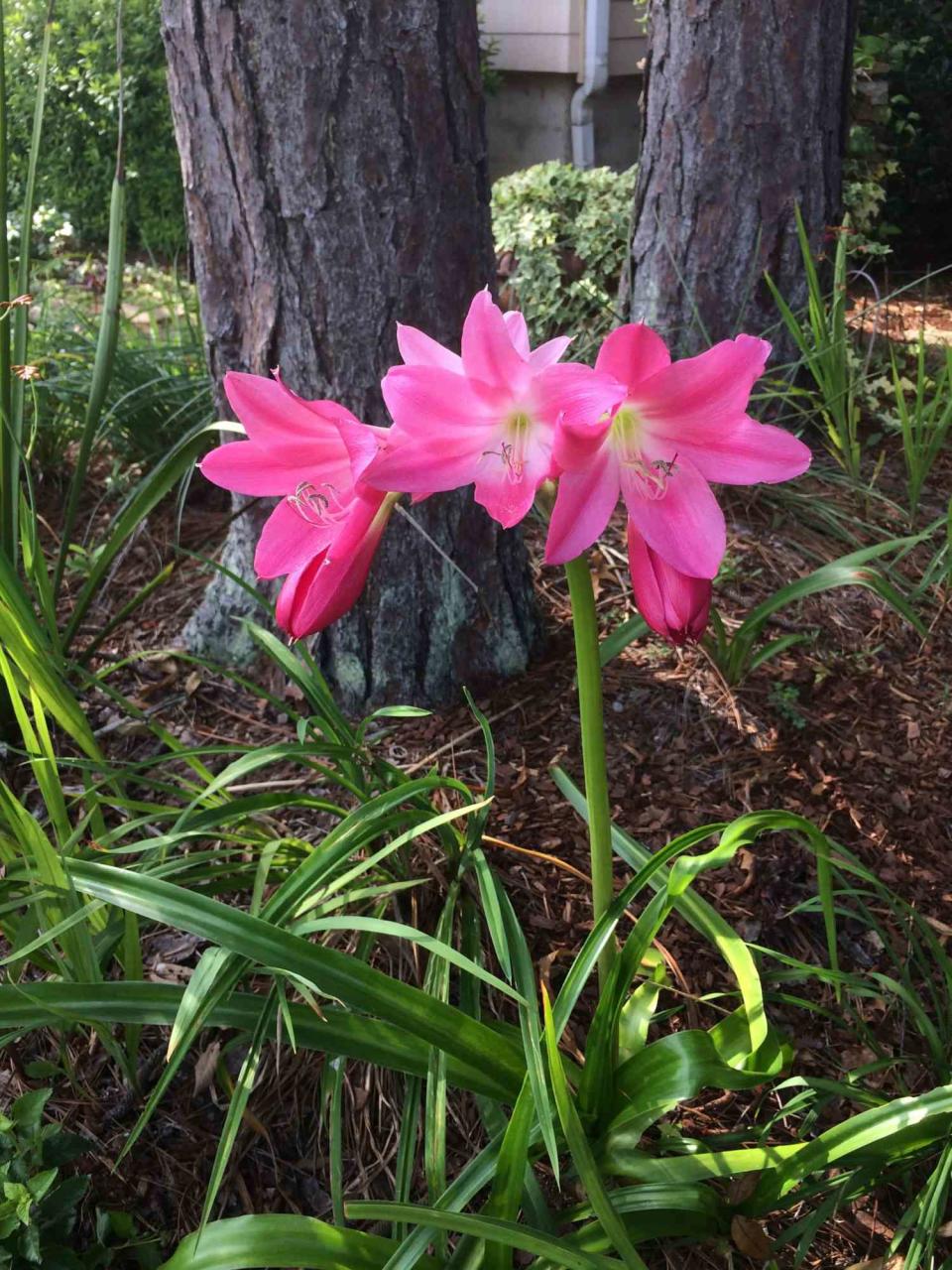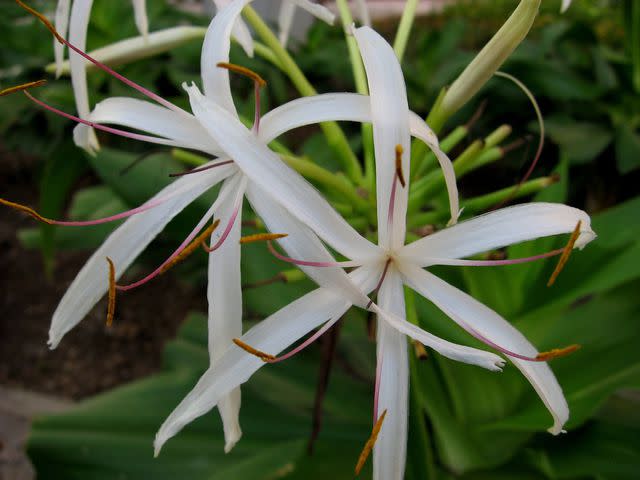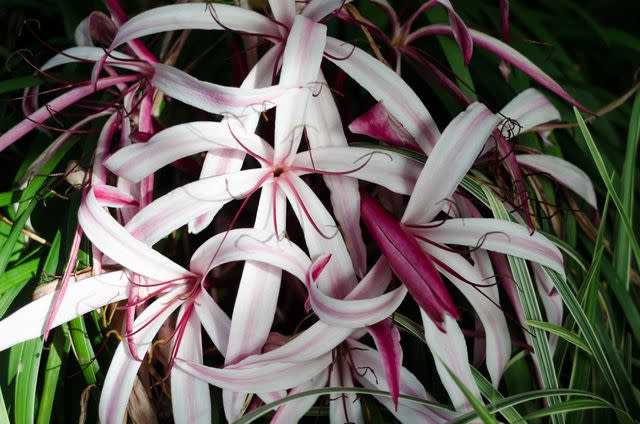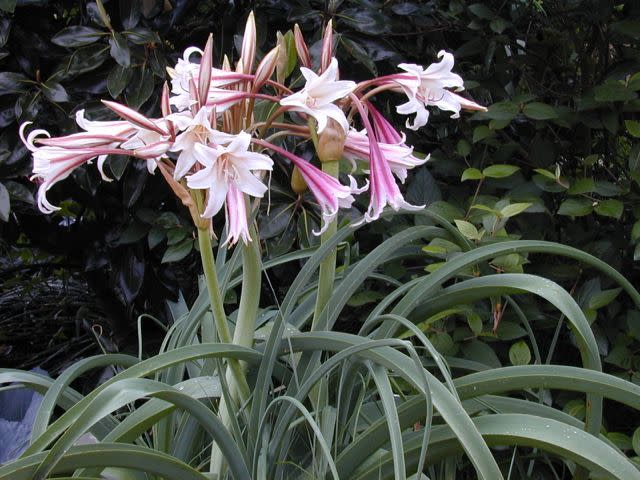How To Grow And Care For The Crinum Lily
Don't torture yourself for that brown thumb. The crinum lily will not waste away on you.

Many types of crinum lilies exist, native to the warmer parts of the Americas and Africa. Some represent a single species, but most that you encounter are hybrids of different species. In general, they combine bold, fragrant flowers with handsome, straplike foliage and a bulldog constitution. Classic passalong plants in the South, they survive untended for decade upon decade in cemeteries, old home sites, and country gardens, blooming year after year.
Once established, your crinums will require little from you aside from occasional irrigation. Be aware that it may take a few years for the plants to re-flower when planted from offshoot bulbs, plant divisions will bloom more quickly.
Plant Attributes
Common name | Crinum lily, poison bulb, spider lily, grand crinum lily |
Botanical name | Crinum asiaticum |
Family | Amaryllidaceae |
Plant type | Bulb |
Mature size | 4-6 feet tall, same size spread |
Sun exposure | Full sun to partial shade |
Soil type | Well-draining, moist soil, organic-rich |
Soil pH | 5.6-7.5 |
Bloom time | Seasonal |
Flower color | White, sometimes marked with pink |
Hardiness zone | 9 to 11 |
Native area | Florida |
Toxicity | All parts of this plant are poisonous |

How To Care For Crinum Lilies
Where not winter hardy, these bulbs are usually grown in containers which are planted outdoors in spring after the last spring frost date and then dug up and brought indoors prior to the first fall frost date for overwintering in a cool sun room.
Plant bulbs in pots that are at least two inches larger in diameter than the bulbs. Bulbs like to be pot-bound. Set each bulb in a pot with the neck exposed. Keep soils moist and fertilize regularly during the growing season. Bring containers inside in fall before first frost for overwintering in a frost-free location. Return containers to the garden after last spring frost date. Propagate by offsets, division or seed. Outdoor plants spread in the garden by suckers to form substantial clumps.
Light
Crinum lily loves the sun. But it’ll accept partial shade, particularly if it’s during the hottest part of the day. It can develop leaf scorch if the intensity of the sun is particularly intense.
Most people will find that 6-8 hours of sunlight is perfect for optimal growth. If you’re in a particularly hot climate, consider 4-6 hours of direct sun and a couple hours of partial shade.
Soil
Your ideal soil for your crinum lily should be moist but well-draining. It should be rich with organic matter and fertile. While this plant can grow in poor soils as well, it will be vigorous with this mix.
Water
Crinum lilies perform best in locations that get consistent watering. Pond borders and poolside placements are common. But don’t limit them to those areas. If you water regularly, you can place these throughout your yard.
While the crinum lily can tolerate infrequent watering, they won’t grow as fast. Short periods of drought are okay, as long as they don’t last more than a few days to a week at most. These may need more water during the hottest times of year.
If there are puddles or the ground is muddy, wait for the water to drain away and the soil to partially dry. Excess water can cause the bulb to develop rot issues.
Temperature And Humidity
In cooler climates, this plant should be brought indoors before cooler weather arrives. Once the temperature dips below the 40’s at night, you run the risk of the leaves becoming cold-damaged. These plants are not frost-hardy at all, and the first frost often causes dieback of foliage.
Fertilizer
For my crinums, I like to use a slow-release, balanced granular fertilizer. Spread this in early spring, early summer, and early fall around the base of plants. Work it lightly into the soil. This should be plenty of food for your plants.
If you’d prefer a liquid, opt for a half-strength liquid fertilizer. From spring through the summer, fertilize monthly. Only fertilize it once early in the fall, and skip the winter entirely.
Propagating
Crinum lilies have a long tradition in the southern U.S. as a pass-along flower owing much to their resilience when dividing the offsets. You can dig and divide the bulbs when starting, or in full growth. The clumps and individual bulbs can get rather large, so digging and dividing the outermost bulbs of the clump is recommended, unless you have access to a backhoe.
Potting And Repotting Crinum Lilies
Crinums tolerate many soils, from wet to well-drained to dry (although blooming is often spurred by spring and summer downpours). Many crinums grow into large clumps of absolutely enormous bulbs that store food reserves.
This means that can they weather long stretches of drought and utter neglect and then bloom when conditions improve. It also means that, unlike most plants, you can dig, transplant, share (and ship) crinums just about any time without killing them.
Overwintering
If you live in zone 8 or 9, you may need to prepare your plants for overwintering. This ensures that any frost won’t hurt the plant. Trim back the leaves to the ground as the weather gets cool. If you’d like, you can cover over the plant with a couple inches of mulch to protect the bulb from chilly conditions.
Those who get frosts and freezes throughout the winter should be ready to move indoors. Crinum lily is not tolerant of freezing weather! Carefully uproot your bulb and place it in a pot just a bit larger than the bulb itself. Fill in around it with soil. Keep it indoors in the brightest area you can find through the chilly months.
It can be really helpful to remove the outermost leaves on bulbs that are moved indoors. This prevents the plant from taking up an excess of space.

Elizabeth Fernandez/Getty Images
Common Pests And Plant Diseases
Some types of grasshoppers, especially the eastern lubber grasshopper, can become a problem. These hungry little pests will devour the leaves of your plant. To combat these, use a bacillus thurigiensis spray or powder. The grasshoppers won’t survive.
Some types of mealybugs find crinum lily to be appetizing. A good spraying of neem oil makes for a deterrent. An insecticidal soap may also be useful if they are persistent.
Nematodes, particularly root-knot nematodes, may become a problem. Use beneficial nematodes to counteract these bad forms. The beneficial ones will protect your plants from a host of other problems, too.
Finally, those long leaves are appealing to both slugs and snails. Not only do they provide daytime cover that the slimies can hide in, but they taste good too. Apply an organic slug and snail bait around your plants to lure them out and kill them off.
How To Get Crinum Lilies To Bloom
Because of their origins, crinums favor the warmer growing areas of USDA Zones 7-11. However, some cold-hardy crinums withstand frigid winters. The hardiest, Crinum bulbispermum, shown below, is fully hardy in USDA Zone 6A, and is reported to have survived -20 degrees. It is prudent to plant them 18 inches deep in this zone, however.

Elsewhere, choose a sunny spot with decent soil for planting. Jenks Farmer, the Guru of Crinums from Columbia, South Carolina, says to first find the "neckline" of the bulb – the point where its color transitions from white to green. Dig a hole six inches deeper than the neckline, place the bulb in the bottom, and cover it with soil. That's it.
Common Problems With Crinum Lilies
As I mentioned above, plants in hot, full-sun conditions can experience leaf scorch. While not common, it does happen when the temperature peaks mid-to-late summer. If you have a large plant, a few scorched leaves won’t cause you any harm. But if it’s young, this may be a problem. Try to place your plants where there’s afternoon shade if you’re in a hot climate.
If overwatered, you may find the bulbs start to rot. They’re tolerant of excess water to a point, but eventually will succumb. Ensure your soil is well-draining to prevent this problem by adding sand or perlite.
If the tips of the leaves are starting to go brown, this is usually a sign of too little water. Be sure the moisture in your soil is consistent. Mulching around your plants can help keep the soil moist for longer periods of time.
Watch: 5 Great Flowers For A Brown Thumb
For more Southern Living news, make sure to sign up for our newsletter!
Read the original article on Southern Living.

